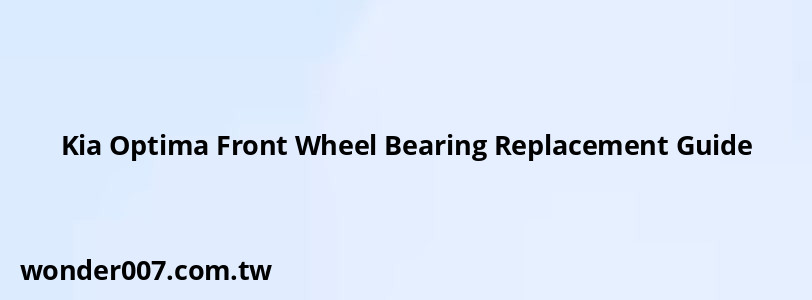Kia Optima Front Wheel Bearing Replacement Guide

Tools and Preparation
Before starting the front wheel bearing replacement on your 2014 Kia Optima, gather the necessary tools:
- Socket set (including 21mm, 32mm, and 14mm sockets)
- Torque wrench
- Impact driver
- Hammer and punch
- Pry bar
- Press tool (optional, but recommended)
Ensure you have a new wheel bearing assembly ready for installation. It's advisable to work in a well-lit area with enough space to maneuver around the vehicle.
Removing the Wheel and Brake Components
Start by loosening the lug nuts while the car is still on the ground. Then, lift the vehicle and secure it on jack stands. Remove the wheel completely.
Next, remove the brake caliper:
- Locate the two 14mm bolts holding the caliper
- Remove these bolts and carefully hang the caliper to avoid stressing the brake line
- Take out the brake pads and set them aside
Remove the brake rotor by taking out the small retaining screws, typically requiring an impact driver for easy removal.
Disconnecting the ABS Sensor and Tie Rod
Locate the ABS sensor on the steering knuckle. Remove the 10mm bolt securing it and carefully pull the sensor out to avoid damage.
For the tie rod:
- Remove the cotter pin
- Use a 17mm socket to remove the tie rod end nut
- Separate the tie rod from the steering knuckle using a tie rod separator tool or by tapping the knuckle with a hammer
Removing the Wheel Bearing Assembly
To remove the wheel bearing assembly:
- Remove the large axle nut (32mm socket)
- Unfasten the bolts connecting the bearing to the steering knuckle
- Carefully separate the bearing assembly from the steering knuckle
If the bearing is press-fit, you may need a hydraulic press or a bearing puller to remove it completely.
Installing the New Wheel Bearing
When installing the new bearing:
- Ensure all mating surfaces are clean
- Press the new bearing into place, making sure it's seated correctly
- Reinstall all bolts and components in reverse order
- Torque all fasteners to manufacturer specifications
Final Steps and Torque Specifications
Reinstall the brake rotor, caliper, and wheel. Torque the lug nuts to the specified value (typically around 65-80 ft-lbs for the Kia Optima).
Important torque specifications:
- Axle nut: 150-200 ft-lbs
- Hub mounting bolts: 50-70 ft-lbs
- Brake caliper bolts: Refer to Kia's specific torque values
After installation, perform a test drive and listen for any unusual noises. It's also recommended to have the wheel alignment checked, as the steering components were disturbed during the process.
FAQs About Kia Optima Front Wheel Bearing Replacement
- How do I know if my wheel bearing needs replacement?
Common signs include grinding noise when driving, steering wheel vibration, or uneven tire wear. - Can I replace just one wheel bearing?
While possible, it's often recommended to replace bearings in pairs for even wear and performance. - Do I need special tools for this job?
While many steps can be done with basic tools, a press tool is often necessary for removing and installing the bearing itself.
Related Posts
-
F250 AC Not Blowing Out Vents: Troubleshooting Guide
29-01-2025 • 216 views -
2011 Ford Escape Rear Wiper Motor: Essential Replacement Guide
29-01-2025 • 220 views -
JLG Boom Lift Warning Lights: Complete Guide
26-01-2025 • 254 views -
2006 Jeep Liberty Turn Signal Relay Location Guide
26-01-2025 • 175 views -
How to Open Gas Tank on Subaru Forester: Easy Guide
29-01-2025 • 219 views
Latest Posts
-
Are O2 Sensors Covered Under Warranty
01-02-2025 • 376 views -
Rear Brake Caliper Piston Won't Compress
01-02-2025 • 356 views -
2015 Chevy Traverse AC Recharge Port Location
01-02-2025 • 409 views -
Power Steering Fluid Leak On Passenger Side
01-02-2025 • 457 views -
How To Turn Off Paddle Shifters Mercedes
01-02-2025 • 377 views
Popular Posts
-
EPC Light: Understanding Causes and Solutions
26-01-2025 • 1053 views -
V12 Engine Costs: What You Need to Know
26-01-2025 • 679 views -
EPC Warning Light: What It Means for Your Vehicle
27-01-2025 • 630 views -
Power Steering and ABS Light On: Causes and Solutions
27-01-2025 • 643 views -
Hino Warning Lights: Understanding Dashboard Alerts
26-01-2025 • 765 views
